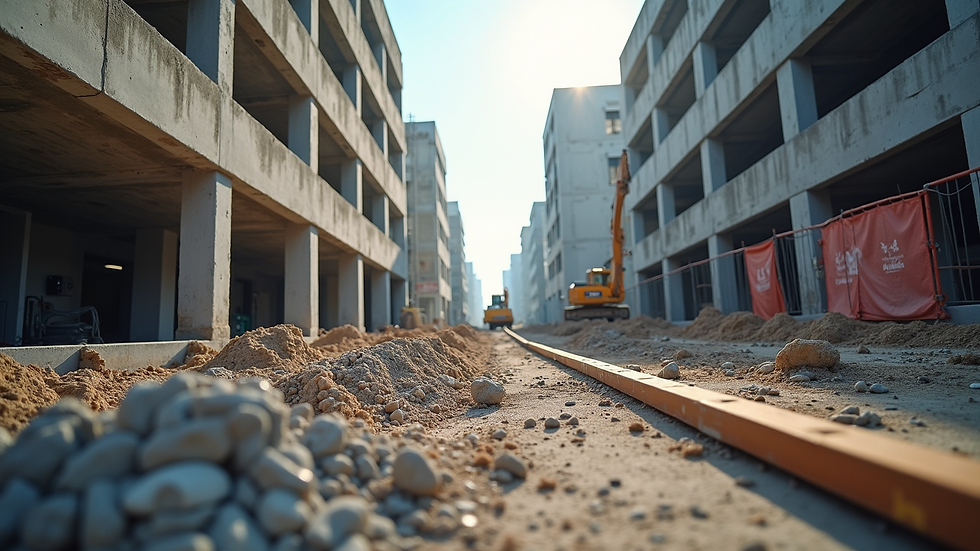Complete Guide to Home Construction Costs in India [2025 Edition]
- HARSH CHAUHAN
- May 30
- 4 min read
Building a home is an exciting journey, but it can also be one of the most expensive undertakings in a person's life. Without a clear understanding of the factors behind construction costs in India, this journey can quickly become overwhelming. This guide aims to provide you with an in-depth overview of the various aspects influencing construction costs in India in 2025, enabling you to make informed decisions along the way.
Understanding the Basics of Home Construction Costs
To get started, it's crucial to know what elements contribute to the total costs of building a home. The primary factors include land cost, construction materials, labor, and various additional expenses like permits and utility connections.
Typically, land costs can differ significantly depending on the location. For instance, urban areas tend to be pricier than rural counterparts. This means selecting a location that matches your budget and lifestyle is vital.
Breakdown of Construction Costs
1. Land Costs
Buying land is often the largest expense in constructing a new home. In 2025, urban centers such as Mumbai and Bengaluru continue to see soaring land prices, often exceeding INR 20,000 per square meter in prime areas. On the other hand, cities like Pune and Jaipur offer more affordable options, with prices averaging around INR 5,000 to 10,000 per square meter.
It's essential to conduct thorough research to identify the best deals that suit your budget and needs. Engaging local real estate agents can also provide valuable insights into current market trends.
2. Construction Materials
The type of materials you choose greatly impacts the overall construction costs. Vital materials include cement, bricks, steel, and wood. As of 2025, there is a growing preference for sustainable materials, which often come with a higher price. For example, using eco-friendly cement might increase expenses by 10 to 15%.
Look for reliable suppliers to ensure quality and compliance with local building codes. Shopping around can help you find competitive prices that align with your budget.
3. Labor Costs
Labor often represents a significant share of the construction budget. As of early 2025, skilled labor rates can vary from INR 500 to 1,000 per day, depending on the region. Cities like Delhi and Mumbai, with high demand for skilled workers, tend to have the highest rates.
Choosing experienced contractors or local skilled laborers who understand the area can lead to efficient management and may help avoid unexpected expenses.
4. Design and Architectural Fees
Hiring an architect can enhance the quality of your home but will add to your total costs. On average, architects may charge between 5% to 10% of the total construction cost. Currently, there’s a shift towards minimalist designs that are functional yet cost-effective.
Investing in thoughtful planning can lead to long-term savings by optimizing the use of space and avoiding costly adjustments later on.
Additional Costs to Consider
When planning your construction, it’s easy to overlook secondary costs that can significantly affect your budget.
1. Permits and Legal Fees
Getting the necessary permits can vary based on the city and the specifics of your construction. Costs might range from INR 5,000 to over INR 50,000 for larger projects. Navigating these legal requirements can be complex, and hiring a local real estate attorney could save time and money.
2. Utility and Connection Fees
Don't forget about utility connection fees for water, sewage, and power. These can range from INR 10,000 to INR 30,000, depending on the location and type of development. Make sure to account for these costs in your budget to avoid surprises.
Cost-Saving Tips
To help manage construction costs, consider these practical tips:
1. Research and Comparison
Always compare prices from various suppliers. Even small differences in material costs can add up significantly. For example, purchasing bulk materials from a single supplier can often cut costs by 10% or more.
2. Avoiding Scope Creep
Keep a close watch on your project's scope. Changing plans mid-construction can lead to a 15% to 20% increase in costs. Finalizing your plans ahead of time is vital.
3. Consider Pre-fabricated Materials
Opting for pre-fabricated components can save both time and labor costs. Homes built with pre-fab materials have shown a decrease in construction time by 20% on average.
4. Sustainability Practices
Incorporating energy-efficient features, although initially more expensive, can cut long-term costs. For instance, homes designed with modern insulation techniques can reduce heating and cooling bills by up to 30%.
Financing Your Home Construction
Most people will need some form of financing to build their homes. In 2025, various options will be available, including bank loans, personal loans, and specific home construction loans.
Understanding interest rates and repayment terms for each option is essential for keeping your budget under control. Be sure to shop around to find the terms that best suit your financial situation.
Future Trends in Home Construction Costs
Looking ahead, several trends are likely to affect construction costs in India in 2025.
1. Advanced Building Technologies
The emergence of advanced technologies, like 3D printing and automation, promises to lower both costs and construction time significantly. This innovation could reduce project timelines by up to 30%.
2. Regulatory Changes
Government policies and regulations can impact costs, making it vital to stay informed about the latest developments.
3. Green Certifications
While achieving green certifications may involve initial costs, they can provide long-term savings and enhance property value. In fact, homes certified under green standards may appraise up to 10% higher than traditional homes.

Having a clear understanding of home construction costs in India is complex but manageable with careful planning. By considering essential factors such as land, materials, labor, and additional expenses, you can navigate the challenges of building a home in 2025.
Applying cost-saving strategies and staying updated on future trends will empower you to create a successful construction project that aligns with your financial and personal goals.




Commentaires